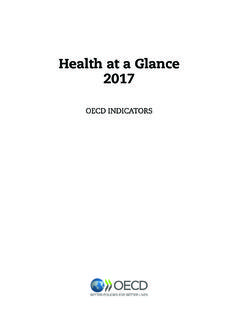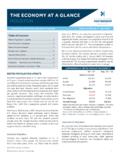Transcription of Health at a Glance 2017: OECD Indicators
1 Health AT A Glance 2017 : OECD Indicators OECD 2017 More via Health at a Glance 2017 : OECD Indicators Health at a Glance provides the latest comparable data and trends on the performance of Health systems in OECD countries. It provides striking evidence of large variations across countries in Health status and Health risks, as well as in the inputs and outputs of Health systems. This edition contains a range of new Indicators , particularly on risk factors for Health . It also places greater emphasis on time trend analysis.
2 Alongside indicator -by- indicator analysis, this edition offers snapshots and dashboard Indicators that summarise the comparative performance of countries, and a special chapter on the main factors driving life expectancy gains. Overview of Health system performance in the United Kingdom The overall Health of British people is similar to the OECD average, considering life expectancy and other general measures of Health status. This is also the case for the major risk factors of smoking and alcohol consumption, but obesity rates are considerably worse than the OECD average.
3 Access to care is generally strong, but Indicators for quality of care are often a little below the OECD average. Health spending is close to the OECD average, but the UK has fewer doctors, nurses and hospital beds. The figure below shows how the UK compares across these and other core Indicators from Health at a Glance . United Kingdom Relative performance compared to the OECD average 1 Standardisation of interquartile range excludes outliers (at least 3 standard deviations from the average) that cause biased statistical distributions.
4 2 Includes measured and self-reported obesity rates. 3 Values for Australia and Canada are reported in median (rather than mean) number of days. AMI = acute myocardial infarction (heart attack), COPD = chronic obstructive pulmonary (lung) disease, OOP = out-of-pocket payments. Health AT A Glance 2017 : OECD Indicators OECD 2017 More via Health at a Glance 2017 : OECD Indicators Health status: life expectancy at birth was 81 years in 2015, close to the OECD average of Risk factors: adult obesity rates are the sixth highest in the OECD ( compared to an OECD average of ).
5 But smoking rates are , a little lower than the OECD average of Alcohol consumption averages litres per adult, down from litres in 2000, but still above the OECD average of 9 litres. Further, harmful drinking among adolescents remains problematic, with of 15-year olds drunk at least twice in their life (the OECD average is 22%). Access: access to care is generally good. Out-of-pocket payments are low, and few people report skipping consultations due to the cost of care ( compared to an average of among 17 OECD countries with comparable data).
6 Waiting times for cataract and other elective surgeries are slightly better than the average (among the 16 OECD countries with comparable data), but have slightly worsened in recent years. Quality of care: while many quality of care Indicators are close to or just below the OECD average, avoidable hospital admissions are high. Admissions for asthma and COPD conditions that can be successfully treated in primary care settings are at 71 and 232 per 100 000 people (compared to respective OECD averages of 47 and 190) Resources: Health spending averages $4 192 per person (adjusted for local costs), slightly higher than the OECD average of $4 003.
7 The UK has doctors per 1 000 population relative to on average across the OECD, and nurses per 1 000 population (the OECD average is ). Selected policy issues Important strides have been taken in improving quality of care, but much more could still be done The United Kingdom s drive to strengthen quality assurance, monitoring and improvement means that it has pioneered and implemented more widely and deeply than elsewhere, many approaches to monitoring and improving Health care quality. Cancer care is an illustrative example of both the good progress made and continuing challenges.
8 Cancer survival rates have improved over time, due in part to high screening rates. Breast and rectal cancer survival rates are now slightly higher than the OECD average, with respectively and of peopled diagnosed living for at least a further 5 years, versus 85% and 61% in the OECD as a whole. Both rose at a faster pace than average over the course of ten years. But colon cancer survival is still below the OECD average (60% compared to ), and overall cancer mortality rates remain relatively high (222 deaths per 100 000 people, compared with an OECD average of 204).
9 Further gains could be made by modifying or avoiding key risk factors, including tobacco use, unhealthy diet and physical activity. Cancer mortality, 1990 and 2015 (or nearest year) rates per 100 000 population19902015 Health AT A Glance 2017 : OECD Indicators OECD 2017 More via Health at a Glance 2017 : OECD Indicators There is scope for improving the quality of care and reducing waste elsewhere in the system For example, more hospital admissions could be managed by primary care services: admissions for asthma and COPD are high, at 71 and 232 per 100 000 people (compared to respective OECD averages of 47 and 190).
10 At the same time, the UK is managing congestive heart failure and diabetes patients relatively well in primary care settings, with low admissions rate for these chronic diseases. Better value for money in the Health care system could be gained by reducing excess bed days. Whilst average length of stay has fallen rapidly in the UK over time (from days in 2000 to 7 days in 2015), delayed discharges are still an important issue. Within the UK, since 2013 England has seen a significant increase in the number of days people stay in hospital after a doctor declares them ready to be discharged or transferred, reaching over 30 additional bed days per 1 000 population in 2015.












